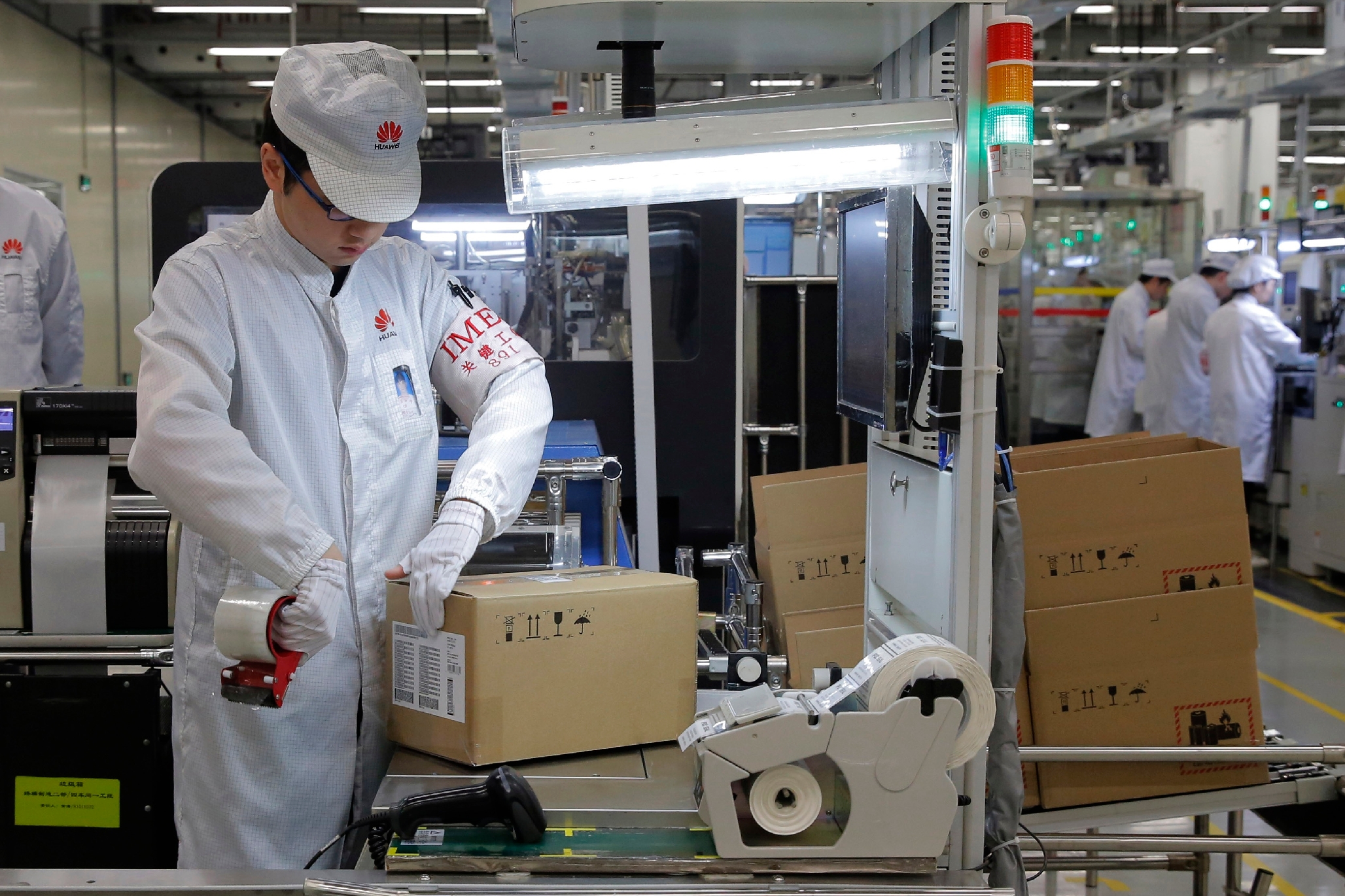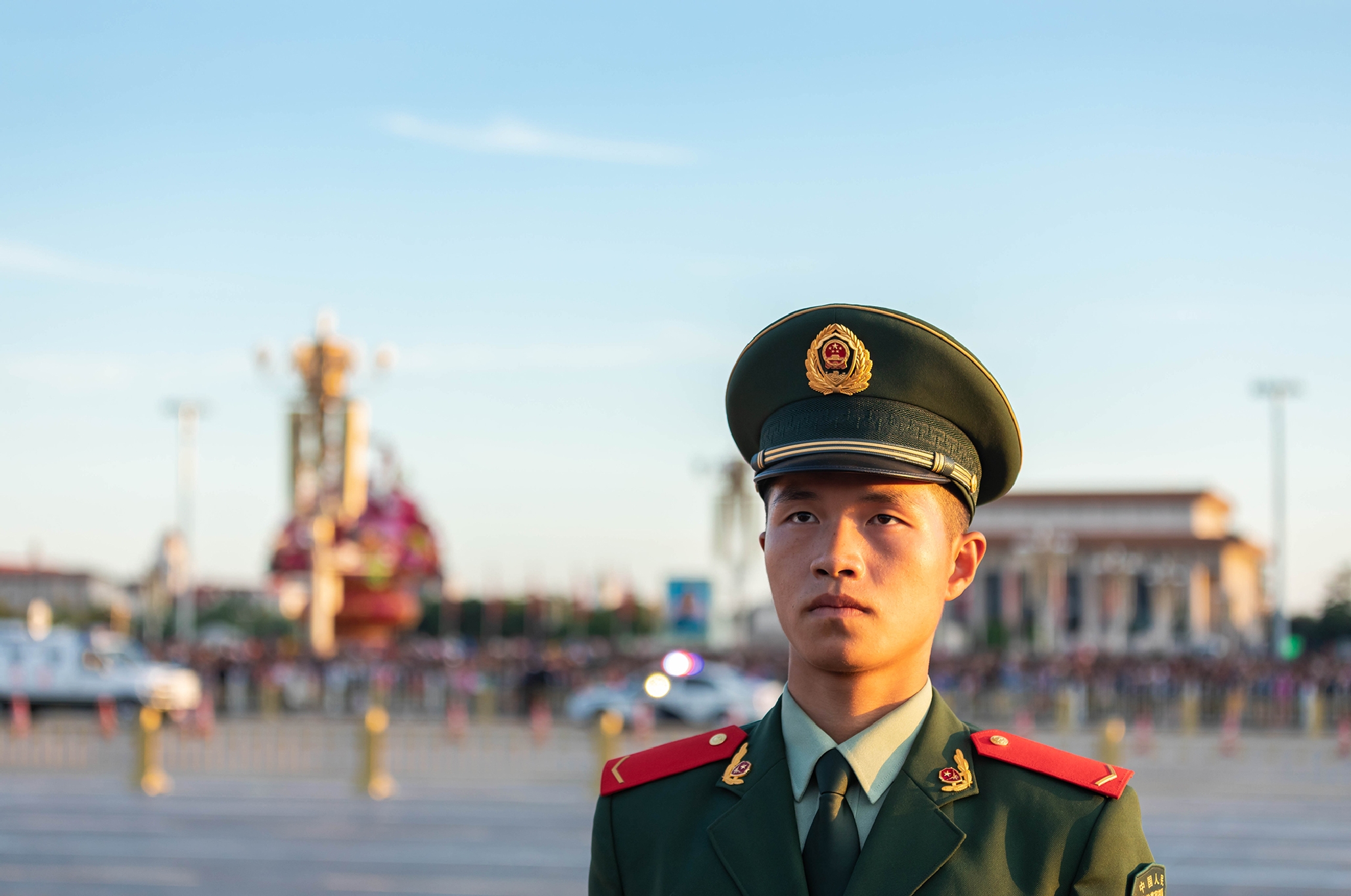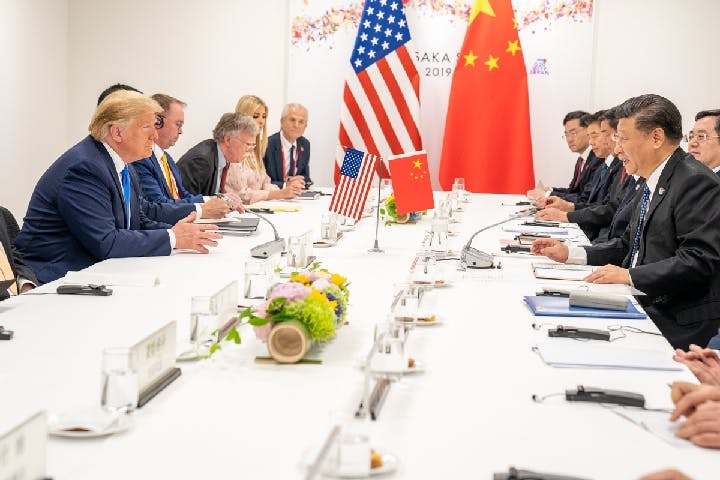Spring 2020
Battlefield 5G
– David E. Sanger and Mary K. Brooks
Are the U.S. and China destined for a forever-war over network control?
In February 2019, Secretary of State Mike Pompeo took a tour through Europe, warning American allies that they faced a stark choice: They could reject the efforts of Chinese firms to wire up their 5G telecommunications networks and remain squarely within the American defense umbrella, or they could welcome the Chinese technology and risk losing access to sensitive American intelligence and perhaps American military bases.
Barely one year later, Pompeo found himself back in Europe — and this time he was backtracking. His ultimatum had failed. Britain had rejected his warning, insisting that they could continue to let firms like Huawei — the Chinese national champion — into their networks and still manage the risk. In a confused series of statements, he and other administration officials continued to warn of the dangers but insisted that key intelligence relationships with American allies would remain as strong as ever.
The change in tone was a belated recognition of reality. Over the course of that year, global consensus had turned decisively against the Trump Administration’s push to keep Chinese-made technology out of the West’s 5G networks. When Britain’s prime minister issued his long-awaited Huawei decision, allowing the company to build parts of the nation’s networks, it was evident that Washington and its allies had dramatically different views of the risk. By the spring of 2020, Germany seemed about to follow in Britain’s footsteps and India had already decided to allow Huawei to participate in the country’s upcoming 5G trials, the precursor to a potential future role in that nation.
Global consensus had turned decisively against the Trump Administration’s push to keep Chinese-made technology out of the West’s 5G networks.
American officials still insist that their effort to persuade allies is not over. And it remains unclear how successful China will be in dominating the construction of the world’s next-generation networks — the new highway that will connect not only people, but the internet-of-things. If it lives up to the promise and the hype, 5G will speed the arrival of a vast new array of technologies, from self-driving cars to sensor-driven “smart” farms to — many fear — autonomous weapons.
So the struggle over 5G is about far more than trade or technological advantage. It is about the power to control a nation’s infrastructure — and, in time of conflict, to cut off an adversary’s ability to communicate. And that makes the geopolitics as important as the technology.
The View from Washington
Until Pompeo’s tour through Europe, most American allies had been treating the building of new cellular networks largely as a procurement decision. While they had heard warnings that installing Chinese-made equipment in their networks could give Beijing a foothold to install “backdoors” that could allow their intelligence agencies to read, divert, or halt digital traffic, these security issues had been considered background noise, not a festering national security crisis. European officials were shocked to find that Pompeo was suddenly presenting 5G as a loyalty test.
The U.S. argument boiled down to this: If Chinese firms — led by Huawei, China’s national telecommunications champion and the world’s second-largest cell phone maker — were allowed to install the hardware and software of the next-generation networks, the Chinese government would gradually amass an unprecedented amount of control over a vast array of infrastructure.

“It’s not just the communications,” one of the officials who conducted classified briefings for European leaders warned. “It would be the gas pipelines, the water supplies, the factory floors, the ‘smart cities’ of the future.”
Yet there was no smoking gun. So the U.S. had to focus on the potential threat: Under a series of recent Chinese intelligence and cybersecurity laws, they argued, Huawei and other Chinese firms are required to comply with any request from Chinese intelligence services to access or create a “backdoor” into another nation’s communications networks. This would allow them to spy or — more ominously — use that power in times of conflict to turn off the networks of their clients.
So the struggle over 5G is about far more than trade or technological advantage. It is about the power to control a nation’s infrastructure — and, in time of conflict, to cut off an adversary’s ability to communicate. And that makes the geopolitics as important as the technology.
It was a dire picture. But, the Europeans argued, it was an entirely speculative one. So far, there was scant evidence that China had used Huawei for nefarious purposes. And so by the end of 2019, the score looked much as it had at the end of 2018: Only Australia had formally announced that it would ban Huawei components in its 5G networks — though New Zealand and Japan had effectively done the same without mentioning the company by name.
Instead, Huawei steadily picked up more customers around the globe. The company announced in February 2020 that it had amassed ninety 5G contracts, just under half of which were with carriers in Europe. While a number of these countries promised to keep Huawei technology out of their core switching systems —and said they would seek Western suppliers for these critical central components — the tide had clearly turned against the Trump Administration. At a moment when America’s influence around the globe appears waning, allies were essentially looking into a crystal ball to discern which of the world’s two largest economies would be more critical to their future.

Inside the Trump administration, there was also significant infighting over how to deal with Beijing. A cluster of powerful China hawks, led by Pompeo, made the case that banning Huawei was non-negotiable. But Treasury Secretary Steve Mnuchin took a more benign view of China’s intentions. President Trump vacillated. At times, he described 5G as a critical national security issue, and declared he would ban the export of sensitive American technology to Chinese manufacturers. At other times, he suggested he might be willing to walk back the bans, presumably in pursuit of a trade deal with China.
The result, not surprisingly, has been confusion among American companies and American allies about what the United States really cares about. And the absence of a clear administration strategy has contributed to a fear that the United States is falling behind on a critical technology.
A Core Debate: 5G and the Future of the Internet
The question of how China’s central role in 5G technology may shape the internet’s future looms larger than any specific debate about whether to let their firms build the telecommunications infrastructure of the Western and Asian allies of the United States. It has also sparked competing visions of what the internet will look like in a few years.
Those in the first camp argue that the controversy surrounding the deployment of 5G networks is part of a larger trend that is leading inevitably to the creation of a new Berlin Wall — a barrier that would stretch around the globe and divide the world into two internets. On one side would be the familiar anarchy of the Western internet, awash in constant commerce, largely free speech, and the inevitable abuses and chaos that come with a vast, unregulated space. On the other would lie a Chinese-controlled “authoritarianet”— a cyberspace in which content is controlled by the government, facial recognition is employed to tighten the ruling party’s control, and artificial intelligence is deployed to sniff out dissent.

These two worlds are already taking shape. But critics of the first vantage point observe that any “cyber wall” is highly permeable. In order to communicate and to conduct business globally, the world will still have to exchange data at blinding speeds — traversing free and authoritarian internets, and secure and less-secure environments. Thus, data remains vulnerable, even if Huawei and other Chinese firms are banished from the United States.
As Sue Gordon, then deputy director of national intelligence, put it bluntly: “You have to presume a dirty network,” and adjust accordingly. Her meaning was clear: The nation that dominated the world of communications since Alexander Graham Bell must accept the reality that it can no longer control its digital environment.
The absence of a clear administration strategy has contributed to a fear that the United States is falling behind on a critical technology.
Senator Mark Warner, the ranking Democrat on the Senate Intelligence Committee and a former telecommunications executive, described the change to his colleagues this way: “We are accustomed to a world in which America invented the internet, set the standards, and manufactured all the key parts. And that world is going away. It’s not coming back.”
But are we destined for a forever-war between two technological giants, whose battleground will be network control, rather than geography? Or is there room for accommodation of a rising technological power — even in the West’s networks — and the potential to craft rules of the road that might exempt the most critical communications networks from the daily, low-level cyber conflicts that major states are fighting every day?
China Makes Its Move
When the world embraced 3G and 4G technologies in the first decades of the twenty-first century, it was joining a system that was essentially designed, built, and controlled by the West. The technology was dominated by American makers: The wireless systems were heavily dependent on switching systems built by Cisco, and wireless radio technology designed by Qualcomm, among others. The West was able to define the technical standards and promote their versions of devices and regulations, granting it a significant competitive advantage.
The Chinese understood quickly that 5G was their moment to catch up. They invested heavily in 5G research and development, licensing some of the technology from American makers (though not always paying for it). Huawei, which began as a domestic telecommunications firm launched by the famously reticent former People’s Liberation Army engineer Ren Zhengfei, became the symbol of China’s global ambitions. By mid-2019 it held an estimated 29 percent share of the world’s telecommunications equipment market.
Yet few in the United States saw this Chinese initiative coming. Huawei was founded in 1987, but it hardly seemed a threat for its first two decades. By the mid-2000s, the company’s successes set off at least a few alarm bells in the ranks of the U.S. government. And by 2012, Huawei was frozen out of U.S. government supply chains following a congressional report warning that installing Huawei gear in the U.S. would be tantamount to letting the Chinese Communist Party wire up the country.

Huawei has always maintained that it is privately owned by its employees. But public reporting on the company has revealed a very close relationship between Huawei and the Chinese government. It thrives largely because of a tight web of state-backed financing, government clientele, and a talent pool with overlap in the military and intelligence services. Yet the U.S. has never been able to prove — at least in the unclassified world — that Huawei is an instrument of the Communist Party, or of the People’s Liberation Army, in which Zhengfei served as a young man. Instead, the Snowden revelations in 2013 exposed that the U.S. government was boring deep inside Huawei’s technology to extend its own intelligence-gathering capacity — essentially convincing Beijing that the United States was doing to China exactly what American officials charge Huawei would do to the United States.
Finally, in 2018, Congress formally banned much of Huawei’s gear from government use. And in December 2018, the chief financial officer of Huawei, Meng Wanzhou — Zhengfei’s daughter — was arrested on charges of violating sanctions against Iran by shipping it Huawei technology. The Chinese cried foul, arguing that Meng was being held in Canada merely for leverage by President Trump. And Trump gave credence to the charge by suggesting she might be let go if there was a good enough trade deal — thus mixing trade, national security, and the integrity of the American justice system.

In sum, it appeared to many critics that the Trump Administration seemed to have settled on a new strategy: Using legal and security mechanisms to stunt Huawei’s rapid growth — including draconic export-import bans, attempts to limit Chinese access to American technology, and the announcement of several racketeering charges against Huawei, some of which are more than a decade old.
Promises, Reality and Strategy
While dozens — if not hundreds — of recently published articles talk about the need for the U.S. to “win the race to 5G,” the conversation rarely focuses on what 5G actually is, what it promises, or what a technological lead might look like.
The real promise of 5G lies not in its speed, but the future applications that speed allows — and the ability to exploit it to usher in new technologies. Previous generations of network connectivity were generally designed for consumers, and network traffic consisted primarily of calls and data.
5G is different: It is designed for machines talking to machines (the “internet-of-things”) and will enable connections between the billions of sensors, robots, autonomous vehicles, and other devices that will continuously feed one another vast amounts of data in the coming years. The implications for industry, national security, and human welfare are revolutionary in scope.
But the question of whether or not the U.S. is in a good position to collect on these benefits of 5G is hotly debated. Key leaders in Congress, the executive branch, and private wireless carriers argue frequently about it. Many of these leaders are asking whether — Huawei aside — the U.S. is actually on track to deploy its own networks in a competitive manner.
.jpg)
The Defense Innovation Board made a convincing case in 2019 that the United States cannot depend on stumbling its way to a lead in 5G deployment merely by assuming that the wizards of Silicon Valley will stay ahead. “The country that owns 5G will own many of these [critical] innovations and set the standards for the rest of the world,’’ the board concluded. “That country is currently not likely to be the United States.”
One key concern is technical: The U.S. has selected a different part of the wireless spectrum for its 5G than much of the rest of the world, a decision that could lead to significant interoperability problems and undercut U.S. industry’s ability to compete globally. Another fear is the persistent local backlash against the installation of 5G small cells across the United States. These frictions are based on both aesthetic and purported health concerns, and they threaten to ensnare 5G deployment in a series of decentralized legal and regulatory battles.
But more broadly, the laser-like focus on Huawei technology obscures the other cybersecurity challenges of 5G, including an increased attack surface — both physical and cyber — caused by the increased density of small cell placements, the accelerated pace of software updates, and the geometrically-increasing number of devices connected in the internet-of-things.
Given the challenges and the high stakes at play, what elements might combine into an effective national 5G strategy? Here are four ideas:
1) Threatening allies doesn’t work. Devising a credible alternative might.
Unsurprisingly, other governments don’t like to be threatened, and many see resisting Washington on this point as a way of pushing back on an “America First” agenda. But NATO allies, and allies in Asia, seem more likely to respond to a positive incentive: A Western supply chain with the reach, effectiveness, and affordability of Huawei.
There are many ideas floating around about how to do this. One is to combine Nokia and Ericsson, two European suppliers that do not enjoy Huawei’s market reach, to create a more competitive alternative. A second is to combine them with an American partner — or even acquire a controlling American stake, as was recently floated by Attorney General William Barr. Congress also seems to be moving this way, including with the recent introduction of a bill by Senators Warner and Burr that calls for a fund designed to develop “5G alternatives to Huawei.” But whatever the corporate configuration, it is clear that the United States and its partners need a Western champion of their own.
NATO allies, and allies in Asia, seem more likely to respond to a positive incentive: A Western supply chain with the reach, effectiveness, and affordability of Huawei.
The question is whether the U.S. is ready to go further than simply protecting companies from takeover to assure that the country’s own technological base is not hollowed out? For decades, such “industrial policy” was a political issue that divided Democrats and Republicans.
Of course, the United States has never been as hands-off as it advertises. DARPA has long financed promising defense technologies. In-Q-Tel has long served as a small-scale venture capitalist for the intelligence community. Defense Innovation Unit (formerly Defense Innovation Unit-Experimental, or DIUx) has been particularly successful at finding commercial firms and products that could be useful for warfighters — and it has invested in a few.
Yet all these have survived by flying under the radar. Their work has not been tied together as part of a national strategy.
2) Learn to live in a world of “dirty networks.’’
No one knows what the internet will look like in a decade. Yet even if the United States is wildly successful — if it keeps Huawei and other Chinese firms out of the core of its 5G networks, and if it builds a Western champion of its own to compete — that won’t be enough. China didn’t need 5G to steal the plans for the F-35. It didn’t need it to steal the most sensitive personal information of twenty-two million Americans — including our country’s national security elite, military, top academics, and contractors — which was contained in security clearance files held by the Office of Personnel Management.
Even if America learns to lock down its domestically-held data, we will need to learn to live with dirty networks.

What does that mean in practical terms? It requires developing a strategy for keeping the most sensitive defense data inside national networks — with better technologies for walling them off — and developing far more reliable encryption technologies for even routine communications going around the world.
Such a policy, however, would require the administration to revise its views on encryption. After the Snowden revelations in 2013, a commission appointed by President Obama and composed of intelligence officials, industry executives, and academics called for the United States to greatly strengthen encryption. The Obama Administration never acted on this recommendation.
Under President Trump, Attorney General William Barr has argued that law enforcement agencies need to maintain a legal “backdoor” to any encrypted system. He did not explain, however, how to manage the risk that any skilled foreign power — starting with China — could leap through that backdoor.
3) Exploiting national security issues for trade concessions is bound to backfire.
When President Trump hinted that he might intervene in the case against Meng Wanzhou, if it would help him win trade concessions from China, it fed into the Communist Party’s narrative that Meng’s arrest was a political move. When he issued an export ban of sensitive U.S. technology to Huawei and then walked it back, he undercut not only his stated rationale for having blocked the technology in the first place but turned national security into a pawn in the larger trade game.
As former chairman of the Federal Communications Commission Tom Wheeler wrote in July 2019, “The Trump administration’s focus on Huawei equipment is not a cybersecurity strategy, and by melding trade policy with cybersecurity, damages each.”
4) Standards-setting and supply chains are boring. And they matter.
It is easy for national security officials to map China’s expanding presence in the South China Sea. But only recently did government officials begin to appreciate how Chinese engineers were flooding the zone of standards-setting meetings, looking to set the parameters of how internet-of-things devices will communicate with 5G networks.
As Beijing moves to tilt the playing field in the other direction, maintaining U.S. technological leadership in global standards-setting won’t be easy. It will require the U.S. government to display both leadership and flexibility. But it is well worth the relatively small cost. The most immediate action should be to recommit to assertive diplomacy at the standards-setting bodies: That is, moving U.S. and allied representatives into key leadership positions and advocating strongly for U.S.-patented technologies to be adopted as standards.
As Beijing moves to tilt the playing field in the other direction, maintaining U.S. technological leadership in global standards-setting won’t be easy.
Manufacturing the parts that fit those standards comes next. Here, the answer seems straightforward: Building Western systems on a foundation of untrusted parts defeats the purpose of the exercise. Just as the U.S. has trusted suppliers for the F-35, it cannot depend on components, or software, of uncertain origin.
The battle over 5G is only a small part of the broader effort to manage the rise of China. But it has become both technologically and symbolically important. It gets to the heart of who will control the systems that make our societies tick. And it will be key to the perception of who holds the levers of global power. We have one last shot at getting it right.
David E. Sanger is a national security correspondent and a senior writer at The New York Times. In a 37-year reporting career, he has been on three Times teams that have won Pulitzer Prizes, most recently in 2017 for international reporting on Russia’s cyber activities surrounding the 2016 presidential election. His newest book, The Perfect Weapon: War, Sabotage and Fear in the Cyber Age, examines the emergence of cyberconflict as a primary way large and small states are competing and undercutting each other, changing the nature of global power.
Mary K. Brooks is an associate producer at Ark Media on the team making the forthcoming HBO documentary“The Perfect Weapon,” based on David Sanger's book of the same name. Ms. Brooks, a 2017 graduate of Harvard College, worked as a researcher on Sanger's book, focusing in particular on China’s role in shaping the internet. She was previously employed at a Washington-DC-based human rights law firm, advocating on behalf of political prisoners.
This piece is an adapted and updated version of a chapter written by David E. Sanger (“Managing the Fifth Generation: America, China, and the Struggle for Technological Dominance) for The Struggle for Power: U.S.-China Relations in The 21st Century, a collection of essays assembled by the Aspen Strategy Group and published in January 2020. The Wilson Quarterly thanks The Aspen Institute and the editors of The Struggle for Power – Leah Bitounis and Jonathon Price – for permission to do so.
Cover Photograph: U.S. President Donald J. Trump and President of the People’s Republic of China, Xi Jinping, meet on June 29, 2019 at the G-20 Summit in Osaka, Japan. (Official White House Photo by Shealah Craighead.)
